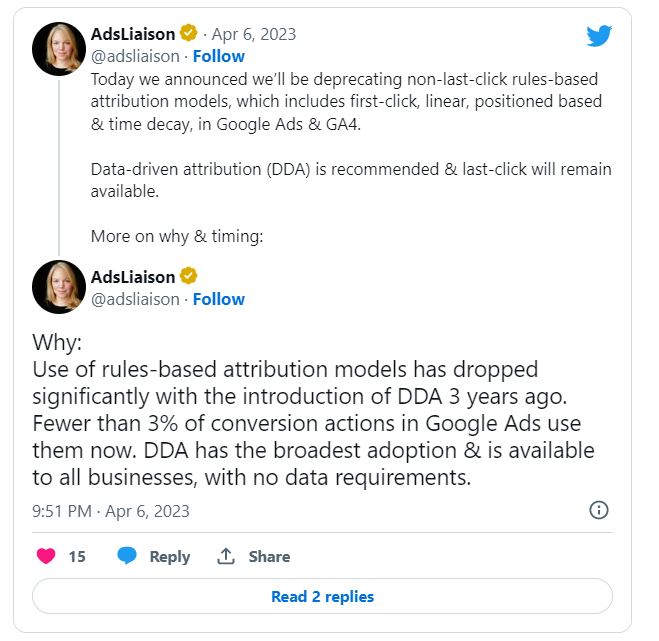Measurement has always been a pain point for marketers, especially in our era of ever increasing privacy restrictions. Unfortunately for some, measurement challenges are about to get more complex. That’s because, as of May 2023, Google will start removing four previously available attribution models within Google Ads and Analytics.
Which measurement options have made the cut? Let’s run through the latest updates.
Removed Google Attribution Models
With this update, Linear, Position Based, First Click, and Time Decay attribution models will no longer be available for new campaigns. For context, here’s a simple breakdown of each of those models, along with their main pros and cons.
- Linear – A linear attribution model gives equal weight to all touchpoints in a consumer journey. It’s helpful in that all channels get credit, however in that, it might over or under value the impact of different channels and messaging. This can lead to a distortion of success.
- Position Based – Position based measurement assigns conversion credit more heavily towards the first and last actions in a consumer journey. The middle actions are still given credit, albeit to a lower degree. This method helps to emphasize key touchpoints, but as a result, can undervalue actions in the middle of the funnel.
- First Click – This method assigns 100% of conversion credit to the very first interaction on a consumers journey. While helpful to understand which channels drive quality leads, it ignores all other touchpoints, including the final action. This method also doesn’t consider the length of time between actions. As a result, It can lead to devaluation of a channel nurturing strategy.
- Time Decay – This attribution model assigns weight over time. It places more significance to actions further down the timeline, as they are more recent. It encourages a multi-touch approach but tends to overvalue the last touch itself. It is also quite complicated to set up and report.
The Remaining Google Attribution Models
With removal of the previously mentioned methods, what alternatives remain? Advertisers will be happy to know the last click and data driven models are still available. The latter of which, has become the default for all campaigns launching after this May. Here’s a breakdown of the two models:
- Data Driven – The data driven approach is unique in that it operates off a collection of signals to determine where to place conversion credit. These signals can include clicks and video engagements on a variety of places including search and shopping, Youtube, display and discovery ads. It then aggregates this data to determine which keywords, ads, and campaigns have the greatest impact on your business goals. This method is also unique to each advertiser based off their ad setup.
It’s helpful to determine which keywords, ads, ad groups, and campaigns contribute best to your conversions. It’s flaw however, is that it’s bound to put Google owned properties in a more positive light.
- Last Click – Likely the most familiar method, last click measurement assigns 100% credit to the last action users take before conversion. It’s beneficial to maximize ad spend efficiency and can help prevent double counting of results. It’s major flaw however, is that it runs contrary to human behaviour. Customers usually require much more than one interaction before making a purchase, particularly if the item is of high value. Relying solely on a last click model can lead you to make investment choices that aren’t aligned with your customer’s journey.
While Google campaigns will automatically be set up under a data driven model from this May onwards, advertisers will still be able to manually select a last click model within their ad accounts.
Why is Google Sunsetting These Attribution Methods?
One might place blame for these changes on privacy precautions. However, according to Google Ads’ official product liaison Ginny Marvin, they are as a result of low usage.

With less than 3% of current users relying on these models, it makes sense for Google to simplify their offerings. This move will also allow them to invest resources into other projects and better adapt to new privacy regulations.
These changes will create some short-term conflict for those who rely on the truncated methods. In effect, however, it brings many advertiser’s measurement systems closer in line with one another.
Advice Moving Forward
So what now? For advertisers relying on the soon-to-be removed models, they are encouraged to make the switch early. Google has granted them until September to fully move over, though the sooner the better. For everyone else, the change will have a minimal impact, if one at all.
As we continue to adapt to the new measurement environment more solutions will be developed. Some new methods are currently being tested today. We’ll explore some of the upcoming solutions and how best to approach them in a future blog post. For now, stay tuned!